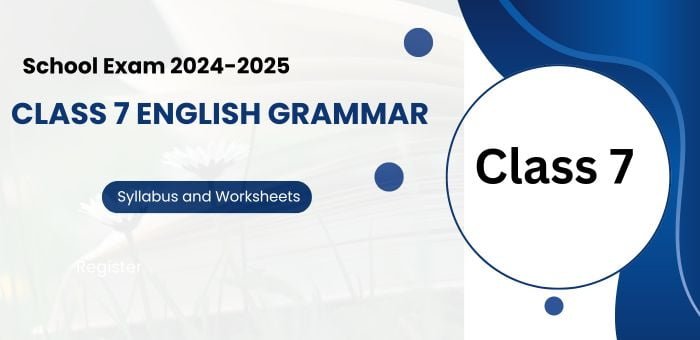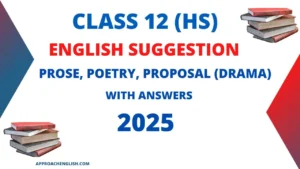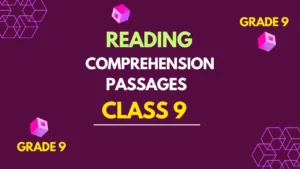Class 7 English Grammar is as vital as any other subject in middle school. Grammar essentially teaches us how to speak, what to speak, to whom we speak, and when to speak appropriately. It’s undoubtedly the core of learning English.
In this article, we will discuss Class 7 English Grammar, introducing the general syllabus for the year 2025. Additionally, at the end of this article, we provide highlights of every chapter and a comprehensive grammar worksheet for Class 7 students to practice at their own pace.
Syllabus for Class 7 English Grammar CBSE and ICSE 2025
Class 7 English Grammar for the 2024-25 session includes a comprehensive syllabus: sentences, nouns (number and gender), pronouns, determiners, adjectives, verbs, verb-subject agreement, tenses, conditional clauses, adverbs, prepositions, conjunctions, voices, speech forms, question tags, vocabulary, and various writing types (notice, message, dialogue, summary, comprehension, letter, paragraph, story, essay). We have also added an integrated grammar section to aid students in preparing for school exams.
Class 7 English Grammar Chapters CBSE, ICSE, and Other Board Exam 2025
Explore the essential English grammar chapters for Class 7 for the 2025 session. These chapters cover various topics to build a strong foundation in grammar and writing skills.
Contents:
1. The Sentence
2. Kinds of Sentences
3. Subject and Predicate
4. Nouns: Kinds of Nouns
5. Number of Nouns, Pronouns, Adjectives
6. Gender of Noun and Pronoun
7. Noun and Case
8. Articles
9. Pronouns
10. Adjectives
11. Degrees of Adjectives
12. Verbs and its Kinds
13. The Present Tenses
14. The Past Tenses
15. The Future Tenses
16. Non-finite Verbs
17. Modals
18. Adverbs
19. Active and Passive Voice
20. Phrases
21. Clauses
23. Prepositions
24. Conditionals
25. Direct and Indirect Speech.
26. Subject-Verb Agreement
27. Punctuation and Capital Letters
28. Transformation of Sentences
29. Integrated Grammar
Highlights of Class 7 English Grammar Contents 2025
Highlights of Class 7 English Grammar Chapters 2025 include a comprehensive study of sentence structure, parts of speech, verb tenses, and various writing skills essential for mastering English.
Chapter 1: The Sentence
Formation of Sentences
- A sentence has a subject and a verb.
- A sentence has complete sense and meaning.
- A sentence begins with a capital letter.
- A sentence ends with a period (.), question mark (?), or exclamation mark (!).
- A sentence generally has more than one word, but sometimes it may be just one word.
Classification of Sentences
Traditional Classification
- Assertive
- Interrogative
- Imperative
- Optative
- Exclamatory
Chapter 2: Kinds of Sentences
Kinds of Sentences
In the study of language, sentences are categorized into different types based on their function and structure. According to function, sentences can be classified into four kinds:
1. declarative,
2. interrogative,
3. imperative,
4. exclamatory.
Each type serves a specific purpose in communication, whether it’s making statements, asking questions, giving commands, or expressing strong emotions.
On the other hand, sentences can also be classified according to their structure, dividing them into three kinds:
1. simple,
2. compound,
3. complex.
Understanding the function and structure of sentences is essential for effective communication and writing.
Chapter 3: Subject and Predicate
In every complete sentence, two main components work together to convey a clear message: the subject and the predicate. Understanding these components is crucial for constructing well-formed sentences.
A. Subject
The subject of a sentence is the person, place, thing, or idea that the sentence is about. It tells who or what is performing the action or being described. For example, in the sentence “The cat sleeps on the mat,” “the cat” is the subject because it is the one performing the action of sleeping.
B. Identifying the Subject
To identify the subject of a sentence, ask yourself “who” or “what” is performing the action or being described. The subject is usually a noun or pronoun and is often found at the beginning of the sentence. For instance, in the sentence “The teacher explains the lesson,” the subject is “The teacher” because the teacher is performing the action of explaining.
C. Predicate
The predicate is the part of the sentence that tells what the subject does or is. It includes the verb and any other details that describe the action or state of the subject. In the sentence “The cat sleeps on the mat,” “sleeps on the mat” is the predicate because it describes what the cat is doing.
D. Identifying the Predicate
To identify the predicate, find the verb first, as the predicate always contains the verb. Then, determine the part of the sentence that tells what the subject is doing or what is being said about the subject. The predicate can include the verb and all the words that complete its meaning. In the sentence “The teacher explains the lesson,” the predicate is “explains the lesson” because it tells what the teacher is doing.
Chapter 4: Nouns: Kinds of Nouns
a. Definition of Nouns?
Nouns are words that denote a person, place, thing, or idea. They form the backbone of sentences, providing essential information about subjects and objects.
b. Types of Nouns
Nouns can be categorized into different types based on their functions and characteristics. Understanding these types is crucial for mastering grammar and communication skills.
1. Proper Nouns
A proper noun refers to the name of a specific person or thing that is unique and distinct from others.
A. Characteristics:
a. Capitalization:
- The first letter of a proper noun always begins with a capital letter.
- Example: Dog, Tree, House
Chapter 5: Number of Nouns, Pronouns, Adjectives
Ways of Forming Plural Number of Nouns, Pronouns, and Adjectives explores various rules and patterns for converting singular forms to plural. It provides examples and exercises to enhance comprehension.
Chapter 6: Gender of Noun and Pronoun
he concept of gender in language has evolved over time. While many ancient languages had strict gender rules, modern languages are increasingly adopting gender-neutral terms to reflect contemporary values and inclusivity. Understanding the historical context of gender usage can provide insights into its current application and future trends.
The Role of Gender of Nouns and Pronouns in Different Languages
Different languages handle gender in various ways. For example, in languages like Spanish and French, nouns have inherent genders, and the corresponding articles and adjectives must agree with the noun’s gender. In contrast, English has a more flexible approach, using gender primarily for pronouns and some specific nouns.
Types of Gender in Nouns
a. Masculine Gender
Definition and Examples
Masculine gender typically refers to male entities. In English, examples include:
Chapter 7: Noun and Case
Noun and pronoun cases refer to the forms that words take to show their function in a sentence.
In English, there are primarily five cases: subjective (nominative), objective (accusative), possessive (genitive), vocative, and dative.
Each case serves a different purpose and is essential for constructing grammatically correct sentences.
Chapter 8: Articles
The words a, an and the are called articles.
A and an are called the indefinite articles because they do not refer to any specific person or thing.
The article the is called the definite article because it refers to a specific person or thing.
English Articles for Class 7: Indefinite Articles
Explore the usage of indefinite articles (a and an) in English grammar for Class 7 students.
The English Article for Class 7 a/an is used
1. before a singular countable noun when it refers to no particular person or thing.
For example,
- I have a car.
- The computer is a machine.
- She is an advocate.
Chapter 9: Pronouns
Noun and pronoun cases refer to the forms that words take to show their function in a sentence.
In English, there are primarily five cases: subjective (nominative), objective (accusative), possessive (genitive), vocative, and dative.
Each case serves a different purpose and is essential for constructing grammatically correct sentences.
The case of nouns can be classified into nominative, objective, possessive, vocative, dative, and Appositive Case.
Cases of Nouns: Detailed Examples” provides comprehensive illustrations of how nouns function across various grammatical cases—nominative, objective, possessive, vocative, dative, and appositive.
Chapter 10: Adjectives
An adjective is a word that qualifies a noun and a pronoun.
Examples:
1. We heard a loud cry.
2. It is a hot day.
3. He spoke in a low voice.
4. I saw a dark cloud in the sky.
USES OF ADJECTIVES:
Adjectives are mainly divided into two categories according to their uses.
(1) Attributive Adjective and (2) Predicative Adjective.
Adjectives that sit right before a noun and express the quality, fault, or condition of the noun i.e. attribute, are called Attributive Adjectives.
Examples:
1. The red pen is on the table.
Chapter 11: Degrees of Adjectives
When we talk about the existence of some quality in a person or a thing, we use the positive degree.
For example,
Sushma is a tall girl.
Vasanthi is an intelligent girl.
Even if the qualities of two people or objects are equal, there is a positive degree.
For example:
Mousumi is as tall as her
Rule: As + adjective + as
Sometimes the Adjective used to compare human quality with animal quality has a Positive Degree.
For example:
(a) John is as brave as a lion.
(b) The wicked man is as cunning as a fox
Chapter 12: Verbs and its Kinds
1. Principal verb:
When a verb is used independently it is called a principal verb.
For example – call, go, read, work, walk, sing, play on
2. Auxiliary verb:
The verb that helps another verb to form Tense, Mood, and Voice is called an Auxiliary verb or Helping verb.
For example – be, have, do, can, could, shall, should, will, would, may, might, must, ought, to, need, dare, used (to).
Chapter 13: The Present Tenses
The present tense in English describes actions or states occurring now or regularly. There are four main types of present tense:
1. Simple Present Tense: Describes habitual actions, general truths, and fixed arrangements (e.g., “She walks to school every day”).
2. Present Continuous Tense: Indicates actions happening right now or temporary situations (e.g., “He is studying for his exams”)
3. Present Perfect Tense: Describes actions that occurred at an unspecified time in the past and are relevant now (e.g., “She has finished her homework”).
4. Present Perfect Continuous Tense: Refers to actions that began in the past and continue into the present (e.g., “They have been playing for two hours”).
Chapter 14: The Past Tenses
4 Types of Past Tense for Class 7
The past tense in English describes actions or states that occurred in the past. 4 Types of Past Tense for class 7 are classified as the –
- Simple Past: Described completed actions, specific events, and sequences (e.g., “She walked to school yesterday”).
- Past Continuous: Indicated actions that were happening at a specific moment in the past or temporary situations (e.g., “He was studying for his exams”).
- Past Perfect: Described actions that occurred before another action in the past and were relevant then (e.g., “She had finished her homework before dinner”).
- Past Perfect Continuous: Referred to actions that began in the past and continued up to a certain point in the past (e.g., “They had been playing for two hours before it started to rain”).
Chapter 15: The Future Tenses
The future tense in English describes actions or states expected to occur. There are four main types of future tense:
- A. Simple Future: Described actions that would happen at a specific time in the future (e.g., “She will walk to school tomorrow”).
- B. Future Continuous: Indicated actions happening at a specific moment in the future (e.g., “He will be studying for his exams”).
- C. Future Perfect: Described actions that would be completed before another action in the future (e.g., “She will have finished her homework by dinner”).
- D. Future Perfect Continuous: Referred to actions that would begin in the past and continue up to a certain point in the future (e.g., “They will have been playing for two hours by the time you arrive”).
Chapter 16: Non-finite Verbs
Non-finite verbs are forms of verbs that do not show tense and number in an independent clause or a sentence.
In English, the non-finite verb forms are
- infinitives,
- participles and
- gerunds.
Chapter 17: Modals
Modals are helping verbs such as can, must, may, might, will, would, and should that are used with other verbs to show that something is certain, possible, or not possible.
Modal verbs are also used to express ability, obligation, and possibility, seek permission, make requests, and give and accept offers.
Chapter 18: Adverbs
An adverb modifies a verb, an adjective or another adverb often describing how, when, where, or to what extent something happens.
For examples:
- She sings beautifully.
- He will arrive tomorrow.
- They played outside.
- The baby is very cute.
- She ran quickly to catch the bus.
There are ten kinds of adverbs ….
Chapter 19: Active and Passive Voice
(a) At first, turn the Object of the active voice into the Subject and write it as the subject of the passive voice at the beginning.
(b) Then Different forms of the ‘Be’ verb and ‘Have’ verb will be placed after the subject in the passive voice, according to the ‘Tense’ and ‘Form’ of the verb of the active voice.
(c) After that past participle form or 3rd form of the main verb of active voice is placed.
(d) Then Preposition, ‘by’ is added.
(e) At last, turn the Subject of the Active voice into the Object and write it as the Object of the Passive voice at the end. Follow the changes of Pronouns.
Chapter 20: Phrases
A phrase is a group of two or more words functioning as a meaningful unit within a sentence or a clause.
For examples,
- The small brown dog barked loudly.
- She has been reading a fascinating book.
- The cake was incredibly delicious.
- He spoke in a very soft voice.
- We went to the park after lunch.
There are various kinds of phrases, but we will only study
- noun phrases,
- verb phrase,
- adjective phrase,
- adverb phrase,
- prepositional phrase
Chapter 21: Clauses
A clause is a group of words which has a verb and a subject.
Clauses that do not need another clause to make sense are called the principal, or main clauses.
A clause that has to depend on another clause in order to make sense is called the subordinate, or dependent clause.
There are three kinds of subordinate clauses-
- Noun clause,
- Adjective clause an
- Adverb clause.
Chapter 22: Conjunctions
A conjunction is a word which is used to join two words, two phrases or two sentences together.
There are three types of conjunctions.
- Coordinating Conjunction
- Subordinating Conjunction
- Correlative Conjunction
A. Join each pair of sentences using the coordinating conjunction given in the brackets.
1. Ants are small. They are strong. (but)
2. We can go to the theatre for a film. We can watch the cricket match at home. (or)
3. Meena wrote a poem on her mother. She did not show it to her. (but)
4. I was unwell. I had to stay home. (so)
5. The thieves broke the locks on the front door. They entered the house easily. (so)
6. Outside, a storm raged. We were safe inside the hotel room. (but)
7. Anu has never learnt how to draw, She can sketch almost anything. (yet)
8. The children wanted to surprise their parents. They hid their gifts under the bed. (so)
Chapter 23: Prepositions
Chapter 24: Conditionals
Chapter 25: Direct and Indirect Speech.
In Narration Change, the speaker’s actual words are called Direct Speech and when someone narrates the speaker’s actual words indirectly but keeps the meaning the same, they are called Indirect Speech.
Chapter 26: Subject-Verb Agreement
1. A plural subject makes a plural verb.
For example,
(i) We are ill.
(ii) They have warm clothes
(iii) Rini and Sanu play chess.
Guidelines 4: Subject-Verb Agreement
2. Uncountable nouns are placed before singular verbs.
For example,
(i) Food is essential for living.
(ii) Health is wealth.
Guidelines 5: Subject-Verb Agreement
3. The Nouns which are plural in form but singular in meaning are singular in use.
For example,
(i) The news is not true.
(ii) Physics is my favourite subject.
Chapter 27: Punctuation and Capital Letters
Chapter 28: Transformation of Sentences
Chapter 29: Integrated Grammar
Types of Worksheets Included
- Practice Worksheets
- Revision Worksheets
- Assessment Worksheets
- Fun Activities Worksheets
Frequently Asked Questions (FAQs)
How often should I practice grammar?
Ideally, practice a few times a week to maintain and improve your grammar skills.
Are these worksheets aligned with the school syllabus?
Yes, the worksheets are designed to align with the Class 7 English grammar syllabus for the 2025 school exams.
Can these worksheets be used for self-study?
Absolutely! These worksheets are perfect for both classroom use and self-study.
Do the worksheets include answers?
Yes, most worksheets come with answer keys to help you check your work.
Preparing for the Class 7 English grammar exam can be a challenging task, but with the right resources, it becomes much more manageable. Our comprehensive worksheets are designed to cover all essential grammar topics, making your preparation thorough and effective. Practice regularly, focus on your weak areas, and use these worksheets to enhance your learning experience. Good luck with your studies!







